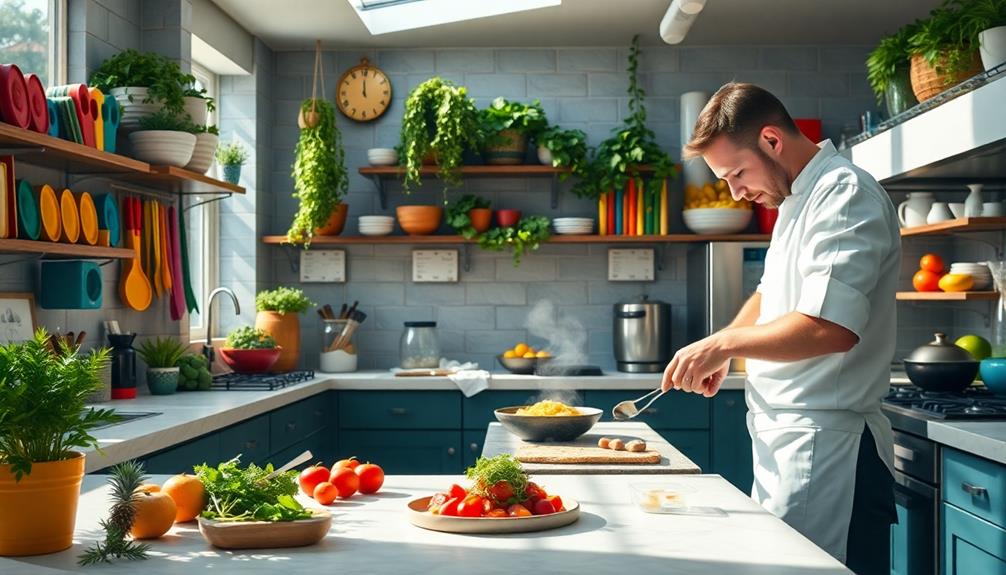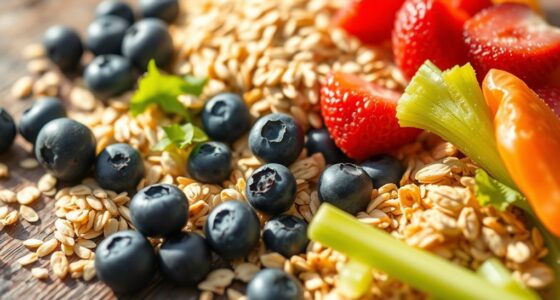Your kitchen design plays an essential role in shaping your cooking habits. An open layout encourages social interaction, making cooking a shared experience. Ample counter space sparks creativity, while organized storage makes accessing ingredients effortless. A well-thought-out design reduces stress during meal prep, enhancing your overall enjoyment. Thoughtful aesthetics can inspire culinary exploration, with lighting and color schemes setting the mood for cooking. Plus, incorporating smart appliances makes tasks easier and more efficient. By focusing on comfort and ergonomics, you can create a kitchen that not only promotes healthier cooking but also inspires you to try new recipes and techniques.
Key Takeaways
- Open concept layouts promote social interaction, encouraging more time spent cooking and entertaining with family and friends.
- Ample counter space fosters culinary experimentation, enhancing creativity and skill development in the kitchen.
- Smart appliances streamline cooking processes, allowing for multitasking and precise management of cooking tasks.
- Ergonomic designs and adjustable features improve comfort and efficiency, making extended cooking sessions more enjoyable.
- Organized kitchens with custom cabinetry facilitate easy access to healthy ingredients, supporting better dietary choices and meal preparation habits.
Modern Kitchen Design Trends

Embracing modern kitchen design trends can transform your cooking space into a hub of creativity and interaction.
Today's modern kitchens prioritize open concept layouts, breaking down barriers between cooking and socializing. This design element not only enhances social interaction but makes the kitchen feel more inviting, encouraging you to spend more time cooking and entertaining.
Incorporating features such as a designated cooking area for preparing fresh, seasonal dishes like Nettle and Potato Soup can further enhance your culinary experience.
Minimalist designs play an essential role in modern kitchens, focusing on functionality and smart storage solutions. By incorporating innovative storage options, you can declutter your kitchen, making it easier to cook efficiently.
Smart appliances are also gaining traction, allowing you to manage cooking tasks remotely and achieve precise results with ease.
Sustainable materials are another key trend, as homeowners increasingly seek eco-friendly options for cabinetry and surfaces. This shift not only benefits the environment but can also inspire you to adopt healthier culinary practices.
Additionally, current color palettes are moving towards bold hues and natural tones, greatly impacting the mood and ambiance of your kitchen. This transformation can ignite your creativity, making cooking a more enjoyable and fulfilling experience.
Embrace these modern design trends and watch your culinary habits flourish.
Open Kitchen Layouts

Open kitchen layouts have become increasingly popular, and for good reason. These designs seamlessly integrate cooking spaces with dining and living areas, promoting social interaction during meal preparation. When you cook in an open kitchen, you're not isolated; instead, you're part of the action, engaging with family and friends. This layout encourages you to whip up home-cooked meals more frequently, as the inviting atmosphere fosters inclusivity.
In Brazil, this communal cooking experience is often reflected in traditional dishes like Caldeirada, where friends and family gather to share vibrant, flavorful meals.
A key feature of open kitchen layouts is the central island or peninsula. These elements provide additional storage and serve as informal dining spots, enhancing the kitchen's functional space. You can easily set up a snack bar or a place for kids to do homework while you cook, making the kitchen a hub of activity.
The absence of walls allows for better visibility and communication, so you can easily chat with guests or keep an eye on the kids while you prepare dinner.
Plus, the versatile nature of open kitchens adapts to various cooking styles and occasions. Whether it's a family gathering or a spontaneous get-together, these layouts invite collaborative culinary experiences that elevate your cooking habits.
Culinary Creativity Boost

An open kitchen layout invites friends and family to gather, turning cooking into a collaborative experience that sparks new ideas.
With plenty of counter space at your disposal, you can experiment with ingredients and techniques without feeling cramped. This freedom not only enhances your culinary skills but also makes the process more enjoyable.
For instance, you might find inspiration to create delicious dishes like Chilaquiles or Quesadillas, encouraging creativity and exploration in the kitchen.
Open Layouts Encourage Collaboration
Kitchens designed with open layouts can transform the way you and your loved ones interact while cooking. These spaces promote collaboration, allowing everyone to engage in culinary activities together. As you prepare meals, the seamless interaction between cooking and socializing enhances your overall cooking experience.
| Benefits of Open Layouts | Description |
|---|---|
| Encourages Collaboration | Everyone can contribute ideas and techniques, boosting creativity. |
| Fosters Inclusivity | Breaks down barriers between kitchen and living spaces. |
| Motivates Home Cooking | Research shows more frequent meals are made when surrounded by others. |
| Central Gathering Spots | Islands or peninsulas serve as informal dining areas. |
| Promotes Spontaneity | Makes it easy for multiple people to join in during meal prep. |
With an open kitchen, you'll find it easier to whip up spontaneous meals as family and friends gather around. The design fosters an inviting atmosphere where collaboration thrives, making cooking not just a task but a shared experience. By creating these gathering spots, you encourage conversation and teamwork, turning meal preparation into a fun and creative endeavor.
Ample Space Fosters Experimentation
When you have ample counter space in your kitchen, it invites you to explore new recipes and techniques, fostering a creative cooking environment. A modern kitchen designed with an open layout and islands gives you that extra room to prepare your meals without feeling cramped.
This freedom encourages culinary creativity, allowing you to experiment with different flavors and ingredients. For instance, imagine whipping up a festive Graveyard Taco Dip for a Halloween gathering, as the spacious layout allows you to layer and decorate without hassle.
With enhanced storage solutions, like pull-out pantries and organized drawers, you can easily access a variety of ingredients. This accessibility inspires you to try out new dishes and expand your cooking repertoire.
Additionally, ergonomic features, such as adjustable countertops, let you work comfortably for longer periods, motivating you to tackle more complex culinary projects.
A well-structured kitchen layout also minimizes stress during meal preparation. By reducing logistical challenges, you can focus on what truly matters—creating delicious meals.
So, when your kitchen offers ample space and organized storage, it's not just about efficiency; it's about releasing your potential as a home cook and enjoying the process of culinary experimentation.
Embrace the space, and let your creativity flourish!
Aesthetics and Mood Impact

The aesthetics of your kitchen can greatly shape your cooking experience and overall mood.
By choosing colors that inspire you and maximizing natural light, you create an environment that encourages creativity and enjoyment.
Incorporating elements that reflect culinary traditions, such as a designated space for preparing dishes like Red-Braised Pork Belly, can enhance the cooking atmosphere.
When your kitchen reflects your personal style, it transforms into a space that motivates you to cook more often.
Color Psychology Effects
Color plays an essential role in shaping the atmosphere and mood of your kitchen, influencing not just aesthetics but also your cooking habits. Warm colors like red and orange stimulate your appetite and create an inviting atmosphere, encouraging you to cook more often.
For instance, when preparing a flavorful dish like Mushroom Masala, the vibrant colors of your kitchen can enhance your desire to explore rich, spice-infused recipes. In contrast, cool colors like blue and green promote calmness and mindfulness during meal preparation, making your cooking experience more enjoyable.
The choice of color palettes affects how you perceive the size and brightness of your space. Lighter colors can make your kitchen feel larger and more open, enhancing your overall cooking experience.
A well-coordinated color scheme can also spark creativity, inspiring you to experiment with new recipes and culinary techniques. Moreover, the finish and color of kitchen materials impact cleanliness perception.
Lighter, glossy surfaces often appear more hygienic, encouraging you to spend more time in your kitchen. By carefully selecting your color scheme, you can create a space that not only looks beautiful but also positively influences your mood and cooking habits, making your kitchen a true haven for culinary exploration.
Natural Light Benefits
Natural light can transform your kitchen into a vibrant hub of activity and creativity. When you allow sunlight to flood your cooking space, you not only enhance visibility but also create an inviting atmosphere that encourages enjoyable cooking. Studies show that exposure to natural light boosts mood and reduces stress, making meal preparation feel less like a chore and more like an enjoyable experience.
| Benefit of Natural Light | Impact on Cooking |
|---|---|
| Improved visibility | Better ingredient assessment |
| Enhanced mood | Increased creativity |
| Welcoming ambiance | More frequent cooking |
| Energy savings | Sustainable kitchen design |
With ample natural light, you can accurately assess the colors and textures of your ingredients, leading to better meal presentation. Incorporating features like windows or skylights in your kitchen design not only lowers the need for artificial lighting but also fosters a welcoming environment. Embracing natural light can markedly elevate your cooking habits, inspiring you to experiment and create in your kitchen.
Design and Inspiration
Creating a kitchen that inspires you involves more than just functionality; it's about crafting an environment that resonates with your personal style and mood. The design can make a world of difference in your culinary experiences, transforming the kitchen into a space where you love to spend time.
For instance, a kitchen that's well-suited for making traditional stuffed pasta can encourage you to try your hand at crafting dishes like agnolotti or pasta alla norma, enhancing your culinary repertoire.
Here are four ways aesthetics and ambiance influence your cooking:
- Color Choice: Warm colors like red and orange stimulate appetite, while cool tones like blue and green create a calm atmosphere for focused cooking.
- Natural Light: Maximizing natural light not only improves mood but also enhances ingredient visibility, sparking creativity during meal preparation.
- Organization: A well-organized kitchen with visually pleasing elements reduces stress and encourages you to experiment with new recipes.
- Personal Style: Thoughtful design elements that reflect your personality can turn your kitchen into a daily source of inspiration, motivating you to engage in cooking activities more frequently.
Investing in a kitchen that prioritizes aesthetics and ambiance can greatly elevate your cooking experience, making it a joyful and rewarding part of your daily routine.
Technology in the Kitchen

Technology in the kitchen has transformed how we cook and manage our meal preparations, making it easier and more efficient than ever before. With smart appliances like ovens and refrigerators, you can control your cooking processes remotely. Imagine adjusting the temperature of your oven from the couch, enhancing convenience during meal prep.
Additionally, the ability to explore diverse cuisines, such as Kue Putu, inspires creativity and adds excitement to daily cooking. Voice-activated assistants integrated into your kitchen streamline multitasking, providing hands-free access to recipes, timers, and grocery lists, so you can focus on what you love—cooking.
Innovative storage solutions, such as smart pull-out pantries and adjustable shelving, optimize your kitchen space and accessibility. This makes it easier to organize ingredients and reduces food waste, allowing you to make the most of what you have.
Plus, technology integration enhances precision in your cooking methods. Smart thermometers and scales guarantee accurate measurements, leading to consistent results in your culinary creations.
With recipe apps and digital screens at your fingertips, you can explore new cuisines and techniques, promoting experimentation and creativity in the kitchen. Embracing these advancements not only elevates your cooking experience but also inspires you to try new things, making every meal an exciting adventure.
Custom Cabinetry Benefits

When you invest in custom cabinetry, you're not just enhancing your kitchen's functionality; you're also elevating its overall aesthetic.
Custom cabinetry provides tailored storage solutions that perfectly fit your kitchen designs and cooking needs. This means you can say goodbye to clutter and hello to a more organized space, allowing you to focus on what truly matters: cooking.
A well-designed kitchen can inspire creativity in your meal preparation, whether you're whipping up a quick turkey sandwich from Thanksgiving leftovers or crafting a comforting turkey soup. ideal for quick meals guarantees that your culinary experience is enjoyable and efficient.
Here are four benefits of custom cabinetry:
- Optimized Storage: Custom designs guarantee every inch of space is utilized, accommodating everything from larger pots to specialty appliances.
- Enhanced Accessibility: With personalized configurations, you can easily reach for tools and ingredients, streamlining your cooking process.
- Improved Organization: Efficient designs help you maintain a tidy kitchen, making it easier to prepare healthy meals and entertain guests.
- Aesthetic Appeal: Custom cabinetry reflects your personal style, transforming your kitchen into an inspiring environment.
Ultimately, investing in custom cabinetry not only promotes functional cooking but can also increase your home's value, making it a worthwhile addition to any kitchen.
Maximizing Space for Health

A well-organized kitchen can be a game changer for your health. When you maximize space in your kitchen, it becomes easier to access healthy ingredients. Consider open shelves and pull-out pantries; they greatly improve accessibility, making it simpler to incorporate nutritious options into your meals.
Efficient kitchen layouts with ample storage for fresh produce and whole foods encourage you to cook at home, reducing your reliance on processed and fast food. For example, having designated areas for ingredients can inspire you to create dishes like Dorayaki (Red Bean Pancake) or utilize fresh vegetables in a revitalizing Hiyashi Chuka.
Organized kitchens streamline meal prep and planning, allowing you to develop healthier eating habits. With proper organization, you can minimize food waste and make meal times more enjoyable. A well-structured kitchen also makes it easier to inventory ingredients, helping to reduce unnecessary purchases and save money. Furthermore, the impact of social media on eating cannot be overlooked, as visually appealing and organized spaces often inspire individuals to experiment with new recipes and share their culinary creations online. This influence can spark creativity and encourage a more diverse and nutritious menu at home.
Maximizing counter space further enhances your cooking experience by providing more room to prepare healthy meals. This extra space encourages you to experiment with new recipes and cooking techniques, elevating your culinary skills.
Additionally, adequate storage solutions for healthy snacks and ingredients support better dietary choices. By creating designated areas for these items, you foster an environment that promotes healthier cooking.
Ultimately, when your kitchen is designed for health and organization, it empowers you to make better choices and enjoy the process of cooking.
Ergonomics and Comfort

Creating an organized kitchen not only supports healthy cooking habits but also enhances your comfort while preparing meals.
Prioritizing ergonomic features in your kitchen design can make a significant difference in your cooking experience. By incorporating thoughtful elements, you can elevate both comfort and efficiency.
Here are four key components to evaluate:
- Adjustable Countertops: These allow you to tailor your workspace to your height, reducing strain during meal prep.
- Efficient Workflow: Arrange your kitchen according to the work triangle concept—sink, stove, refrigerator—to facilitate smooth movement and minimize unnecessary bending.
- Ergonomic Storage Solutions: Use pull-out racks and drawer dividers to keep tools easily accessible, which helps you avoid awkward reaching and enhances workflow.
- Comfortable Seating: Incorporate counter heights and seating that support longer cooking sessions, preventing fatigue and discomfort.
Frequently Asked Questions
How Does Kitchen Design Affect Family Meal Preparation Dynamics?
Kitchen design affects family meal preparation dynamics by shaping how you interact and collaborate. An open layout encourages conversation, while efficient storage helps you find ingredients quickly, making cooking together more enjoyable and organized.
What Role Does Color Play in Kitchen Design and Cooking Motivation?
Color greatly impacts your mood and energy in the kitchen. Bright colors can boost your motivation, while calming hues might make you feel relaxed. Choose shades that inspire you to create and enjoy cooking more.
Can Kitchen Layout Influence the Likelihood of Cooking for Guests?
A well-planned kitchen layout encourages you to invite guests over. If the space flows well, you're more likely to engage in cooking, creating memorable experiences and delicious meals for your friends and family.
How Do Kitchen Designs Accommodate Dietary Lifestyle Changes?
"You are what you eat," and your kitchen design can reflect that. With flexible layouts, ample storage, and dedicated spaces, it caters to your dietary changes, making meal prep more efficient and enjoyable for your lifestyle.
Are There Specific Designs That Encourage Cooking With Children?
Yes, designs with lower countertops, open spaces, and accessible tools encourage cooking with children. Incorporating playful colors and fun storage solutions can make the kitchen inviting, fostering creativity and collaboration during meal preparation together.
Conclusion
In the end, your kitchen isn't just a place to cook; it's a canvas for your culinary artistry. Imagine chopping fresh herbs under warm, ambient lighting, surrounded by sleek cabinetry that keeps everything within reach. With an open layout inviting laughter and conversation, you'll find joy in every meal. Embracing modern design and smart technology transforms cooking from a chore into a delightful experience, inspiring you to whip up delicious creations that nourish both body and soul.










